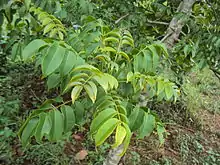Spondias pinnata
Spondias pinnata is a species of tree first described by Carl Linnaeus the Younger. It is in the family Anacardiaceae.[2][3][4] This species, among several others, has sometimes called the "wild (or forest) mango" in other languages and was once placed in the genus Mangifera.
| Spondias pinnata | |
|---|---|
 | |
| Leaves | |
 | |
| Trunk of specimen in Cat Tien National Park | |
| Scientific classification | |
| Kingdom: | Plantae |
| Clade: | Tracheophytes |
| Clade: | Angiosperms |
| Clade: | Eudicots |
| Clade: | Rosids |
| Order: | Sapindales |
| Family: | Anacardiaceae |
| Genus: | Spondias |
| Species: | S. pinnata |
| Binomial name | |
| Spondias pinnata | |
| Synonyms | |
|
List
| |
Spondias pinnata is found in lowlands and hill forests up to 1,200 m (3,900 ft).[5] It is probably native to Malesia, the Philippines and Indochina.[5] It has also been widely cultivated and naturalized in Bhutan, China (southern), India, Myanmar, and Nepal.[5]
Description
Spondias pinnata is a deciduous tree, 10–15 m tall (sometimes up to 25 m in height); branchlets yellowish brown and glabrous.[5] The leaves are large, with pairs of leaflets (see illustration) on petioles that are 100–150 mm and glabrous; leaf blades 300–400 mm, imparipinnately compound with 5-11 opposite leaflets; leaflet petiolule 3–5 mm; leaflet blade ovate-oblong to elliptic-oblong, 70-120 × 40–50 mm, papery, glabrous on both sides, with margins that are serrate or entire; the apex is acuminate, lateral veins 12-25 pairs.
The inflorescence is paniculate, terminal, 250–350 mm and glabrous, with basal first order branches 100–150 mm. The flowers are mostly sessile and small, white and glabrous; calyx lobes are triangular, approx. 0.5 mm. Petals are ovate-oblong, approximately 2.5 × 1.5 mm; stamens are approximately 1.5 mm.
The fruit is a drupe ellipsoid to elliptic-ovoid, olive green becoming yellowish orange at maturity, 35-50 × 25–35 mm; inner part of endocarp woody and grooved, outer part fibrous; mature fruit usually have 2 or 3 seeds. In China, it flowers from April–June and fruits from August–September.[5]
Vernacular names
Spondias pinnata may be called in:
- Chinese: 槟榔青 bing lang qing[5]
- Khmer /pɷːn siː pʰlaɛ/ (ពោនស៊ីផ្លែ) or /məkaʔ prẹj/ (ម្កាក់ព្រៃ),[6]
- Kannada: "Amate Kaai"
- Tamil: Pulicha kaai (meaning "sour fruit"); in Sri Lanka it is also called Amberella
- Thai: มะกอก, Makok (eponym of the Thai capital Bangkok[7][8])
- Tulu and Konkani: Ambade
- Vietnamese: Cóc rừng ('forest [mango-type fruit]')
- Assamese language: Amora
- Malayalam: Ambhazham
References
- Suppl. Pl. 156. 1782
- Kurz, 1875 In: Prelim. Rep. For. et Veg. Pegu. Append. A. 44, app. B. 42
- Roskov Y.; Kunze T.; Orrell T.; Abucay L.; Paglinawan L.; Culham A.; Bailly N.; Kirk P.; Bourgoin T.; Baillargeon G.; Decock W.; De Wever A. (2014). Didžiulis V. (ed.). "Species 2000 & ITIS Catalogue of Life: 2014 Annual Checklist". Species 2000: Reading, UK. Retrieved 26 May 2014.
- World Plants: Synonymic Checklists of the Vascular Plants of the World
- "Spondias pinnata". Flora of China. 11: 339. Retrieved 8 March 2017.
- LETI, Mathieu, HUL Sovanmoly, Jean-Gabriel FOUCHÉ, CHENG Sun Kaing, Bruno DAVID, Flore photographique du Cambodge, Paris: Privat, 2013, p. 63.
- Klaus Wenk (1968). The restoration of Thailand under Rama I, 1782–1809. Association for Asian Studies/University of Arizona Press. p. 18.
- William Warren (2002). Bangkok. Reaktion Books. p. 13.

.jpg.webp)

